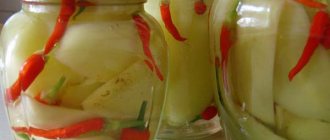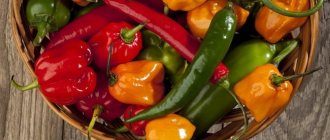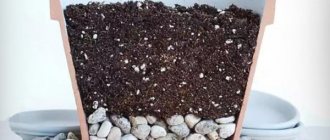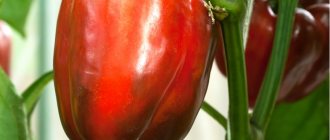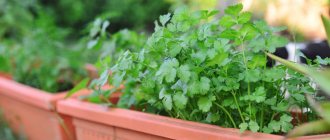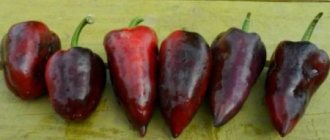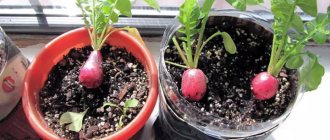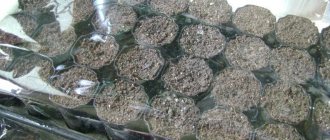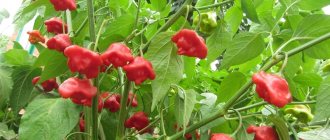Growing peppers at home
Hello, dear readers!
Sweet peppers love warm soil and the best place for growing them in pots is a window sill. In summer, plants receive light and an increased dose of heat through the glass; in winter, they are heated by heating radiators located below. Only plantings are placed on windows in those rooms where there is no balcony, and in winter the windows are rarely opened, since a cold draft can destroy the entire home mini-plantation.
Growing peppers at home
To obtain low bushes of regular shape with large thick-walled fruits and maximum fruiting, seeds of determinate F1 hybrids are used. It is better to choose types of peppers that are early in maturity and do not require pollination.
When properly maintained, such plants are practically not susceptible to disease, delight with homemade fruits with excellent taste, and are capable of producing crops for 8-10 months after planting.
In order for the entire process of growing pepper at home to be a plus, the plant needs to create favorable conditions and remember that this is an agricultural hybrid crop intended for cultivation in industrial greenhouses. Light, warmth, high-quality water (not containing chlorine), loose nutritious soil, spraying and timely fertilizing are the main and necessary for maximum plant productivity.
When growing pepper in pots in an apartment (any garden crop), ready-made flower soils and substrates with neutral acidity, sold in stores, are used. If you use ordinary soil from a summer cottage, then over time all indoor plants will suffer from the appearance of garden parasites and pests. It is advisable to place indoor and garden flora in different rooms so that they do not exchange their “narrow-profile” diseases and parasitic organisms with each other.
Planting hybrids
Most gardeners, following an incomprehensible habit, grow pepper seeds in three stages: seedlings, picking with replanting for rooting in another container, followed by final transfer to pots or narrow containers. In indoor growing, this process is not necessary, there are no pressing deadlines for autumn harvesting, and there is also no threat of cold snaps and night frosts.
Pepper seeds are planted in flower containers 20-25 cm high, leaving a gap of 50 cm between them, or in separate ceramic containers with a volume of 1.5 to 2 liters. Drop two seeds into the hole, spill well and cover with disposable, transparent cups.
The root volume of determinate pepper varieties is small, so large pots are not necessary.
The containers in which peppers are planted must be stable so that during the process of growth and fruit formation the bushes do not tip over under their own weight and increasing size.
Of the two seedlings that appear, the best seedling is left in each planting, removing or replanting the weak one separately. The sprouts under the cups are sprayed with settled water, and when 6-7 leaves appear, the cover is removed and the first fertilizing is applied.
With the formation of the first flower stalks, all plants are sprayed with a preparation to stimulate flowering, for example “Bud” or “Color”. This will not harm, but will greatly improve and increase the formation of fruit ovaries in the further growing season of the pepper.
Once the fruits appear, it is better to tie up the branches and strengthen the plant itself to prevent it from tipping over due to the growing weight of the crop.
Feeding
Growing peppers at home
, it is fertilized with humic compounds with a dosed content of organic matter and microelements, for example “Baikal” or “Ideal”. Fertilizing should be alternated with a mineral group of fertilizers so that an excess of organic matter with active biological organisms and nitrogen does not form in closed planting containers. You can use ordinary nutrient granules and powders for indoor flowers, which contain potassium and phosphate salts.
Sawdust, vermiculite, ash and a small amount of granular sand mixed with the top, fertile layer would be a good addition as a substrate.
Sweet peppers are grown not only on window sills, they can be placed in any corner of the room, but this requires continuous 12-hour illumination with “daytime” fluorescent lamps. Such lighting is most often made from economical, inexpensive lamps used to illuminate aquariums, as well as retail display cases.
I advise on
About growing small red peppers on the windowsill
Valentina Grigorieva
In principle, there are no difficulties, the only thing is that aphids love it very much, but if you treat it with some appropriate drug, you can easily get rid of it. I grow these (hot) peppers all the time. At first I dragged it to the garden every year - in the spring, and back in the fall, but now I grow it both there and there. In the first photo it is slightly bald, this is an autumn photo of pepper brought from the garden, and in the second (spring photo) it is already in full bloom in a green pot . Yes, I forgot to say - there is no need to pollinate it, it will pollinate itself and set fruit. By winter it will grow big and fluffy, looking like a Christmas tree.
Valentina Timofeeva
I think, like an ordinary sweet pepper, the soil would be fertile and the watering would be correct
Natalie
Do not grow in the sun and pollinate yourself, do not pollinate - there will be no peppers
I live as I want to
loves organic matter, warmth and watering,
brownie
This is a light. hot, very beautiful pepper. Grow it on a windowsill - no problem. no special care required.
You've signed up...
A wonderful thing they recommend here is to pollinate. Pepper is a self-pollinating plant and pollinates itself without outside help.
ANNA ORLOVA
The simplest fruit-bearing plant. Perennial. Only spider mites love it)
Girl with a fan
Thank you for the positive emotions, we laughed heartily. “Difficulties must be overcome” - plow the soil in a pot and, drenched in sweat, sow the terribly “expensive” pepper seeds. I overcame such difficulties when I was 10-12 years old.
Alla Lebedeva
Sit down, there’s nothing difficult.
Tatiana Afonina
What are the difficulties here? Sow seeds in a pot? Or watch how the pepper develops? Nowadays there are all kinds of potted pepper seeds. 4-5 varieties can be found in the seed departments. Watering on time, not overwatering, treating for pests if necessary. And that's all.
Aina
not the slightest effort - you plant a seed and water it.
Sergiy
Just like regular peppers, they will grow easily. In winter it is advisable to highlight it.
How to grow peppers at home as in the pictures
Pepper is a vegetable loved by many and, moreover, rich in nutrients. Hot peppers are used to add piquancy to a dish, and sweet peppers are widely used for spring and summer salads and canning. I must say that in the spring the prices for pepper are quite high, but what a pleasure it is to grow it yourself. Yes, yes, peppers can be grown at home. Of course, in order for your tenant to grow, bear fruit and generally look like the pepper in the pictures, you will need to tinker. But the result is worth it. This is not only moral satisfaction, but also the presence of fresh pepper, without GMOs and other impurities, in the house twice a year.
How to understand that pollination was successful?
Unfortunately, you will not be able to understand the effectiveness of pollination until after a week. Only after the specified period will the first fruits begin to appear on the peppers. Only then can we judge that pollination was successful.
In our climate zone there are almost no diseases. And there is only one pest - the Colorado potato beetle, but it pays attention to the pepper only when everything else has been eaten. But other flying insects are very necessary for pollination of pepper to be successful.
Where to start growing peppers at home
First you need to purchase seeds. Remember that the best time to plant any plant, including pepper, is spring, when sap begins to flow and nature comes to life. It has been proven that a plant planted in spring is better accepted and grows faster, acclimatizing less. In the case of pepper seeds, the optimal time for sowing is the end of February - beginning of March. On average, 2-3 weeks pass from the moment of sowing to the germination of sprouts. Make sure there is a sunny window, this is the most important factor for successful growth, although pepper is a shade-tolerant plant.
When choosing a variety for home growing, give preference to small ones that will not be cramped in a flower pot. Pay attention to their freshness - the fresher they are, the more seeds will germinate. 1-2 years is normal; seeds that are fresh at 3 years are no longer worth taking. By the way, it is recommended to transplant grown peppers to a permanent place of residence after they have flourished in the first fork.
It is better to sow seeds in small 100 ml cups or in cassettes. Many people use plastic salad containers for sowing, which are sold in the prepared food departments of supermarkets. Before sowing, you can soak the seeds in growth stimulants, or you can simply try sowing several seeds - if their germination rate is almost 100%, there is no point in soaking.
When buying land, pay attention to the composition; the optimal ratio is an equal ratio of peat, turf and leaf soil, sand, and you can add humus.
When you transplant already sprouted sprouts to a permanent habitat, remember that the root system of pepper does not like crowding. Otherwise, you will not see a full harvest. A pot with a capacity of 2 liters is optimal. Well, at least 1 liter.
Growing seedlings and feeding them
To grow pepper seedlings, the process of sowing seeds should begin at the end of February.
Before placing the seeds in the soil, they must be properly processed. Seeds are disinfected for half an hour in a 1% solution of potassium permanganate (potassium permanganate), after which they must be washed with water. Then the seeds must be treated with a growth stimulant, for example: Albit, Epin or Zircon. To make sure that the grown seedlings will not be attacked by the fungus, the seeds can be treated with Immunofyte. After all the treatments performed, the pepper seeds are planted in small separate pots.
The depth of immersion of the seed in the soil should be 0.6-1.3 cm; during germination, the temperature in the greenhouse should vary from +25 to 30 °C. When seedlings appear, on the 4-5th day, the temperature can be reduced to +16-18 ° C, it should remain lower for about a week, this is necessary so that the plants do not stretch in length. After a week, it must be increased again to +22-28 °C.
The first feeding of pepper seedlings is done when three full leaves appear on the bushes.
For feeding you need to mix:
- 125 g superphosphate;
- 50 g urea;
- 30 g potassium salt;
- 10 liters of water.
After feeding, the seedlings are watered with clean water. The second feeding is carried out at the stage of appearance of the 4th leaf of the seedlings. But at the moment when the bush acquires 7-8 leaves, fertilizing should be especially active and plentiful, because at this time, unnoticed by the observer, flower organs are formed, which subsequently provide the basis for the entire future harvest. During the entire period of growing seedlings, soil is added to the pots twice.
Return to contents
Features of care
Your new army of sprouted residents will require moderate watering as the soil dries out. Excessive humidity is not needed, but there is no need to let the earthen ball dry out. Dip your finger into the ground one phalange - if you don’t feel the soil moisture, you need to water it. If you are worried about your manicure, you can use wooden sticks to determine the moisture content - for example, small skewers that are used to serve shish kebab.
Seedlings do not like cold and drafts, so in the cool season it is better to put a layer of foam on the windowsill. You should take care of a place with good lighting. Optimally - a glazed balcony or loggia.
On some varieties, the appearance of white dots on the reverse side of the leaf is acceptable.
For a successful harvest, peppers need to self-pollinate during the flowering period - to do this, walk over the inflorescences with a soft brush and transfer pollen from one inflorescence to another. Remember: you cannot pollinate sweet and bitter peppers at the same time, even if they bloom at the same time, otherwise all the fruits will be bitter.
Planting and caring for peppers.
Pepper is valuable for its high content of various vitamins (especially C) and mineral salts. In terms of ascorbic acid content, ripe fruits are second only to rose hips. Volatile essential oils give them a special aroma. The tender, juicy and fleshy pulp contains a small amount of fiber and up to 5% sugars.
Sweet peppers grow successfully in greenhouses and under film covers. In warm zones, early ripening varieties can also be grown in open ground, protected from cold winds. Plants grow well in warm soils rich in humus. Acidic soils are completely unsuitable for them. The stem of the pepper is herbaceous at the top, woody at the base, the flowers are large with a white corolla, bisexual, have 6 - 8 petals. The shape of the fruit is varied - from cylindrical to spherical, their surface is smooth or wavy, corrugated.
Read more…
Do you need fertilizers?
In order to achieve full development of the plant and crop, do not forget about periodic feeding. It is important to understand that moderation is the key. It is better to underfeed the pepper than to overfeed it. You can buy a universal fertilizer for indoor flowers, or even better, water the pepper with a solution of wood ash, stirring 6 tablespoons in a three-liter jar and watering once a month.
In principle, you can fertilize with any complex fertilizer, diluted according to the instructions, and it’s good if, in addition to phosphorus, nitrogen and potassium, there are also microelements.
Pepper diseases.
There are many diseases that can significantly affect the quantity as well as quality of pepper harvest. One of them is Alternaria .
The disease appears on the leaves in the form of rounded dark brown spots. From the leaves the disease spreads to the fruits, where the disease manifests itself in the form of water spots. As the disease progresses, areas with fungal mycelium appear on the fruit. In rainy years, the mycelium becomes covered with fluff, forming round-shaped affected areas. With more severe damage, the fruits become covered with a dark coating.
Alternaria has the peculiarity of developing inside the fetus. A light spot on the outside may conceal complete damage to the seeds and pulp inside the fruit. The disease has the ability to progress during fruit storage.
The cause of the disease is the fungus Alternaria solani Sor. The fungus develops with the help of conidia. It has the ability to survive on plant debris.
Read more…
Why peppers don’t bear fruit at home
It happens that everything seems to be done according to the instructions, but the pepper does not look like in the pictures - it stretches out and does not bear fruit. The cause of stretching may be a lack of light and fresh air. But the reasons for the lack of flowering and harvest may be as follows:
- Lack of pollination.
- The daytime temperature is too high or the night temperature is too low.
- Excessive watering.
- The fertilizer contains too much nitrogen.
- Low humidity.
- Irrigation water contains many harmful impurities.
CveTochki.net
Hardening of seedlings and planting in a greenhouse
About two weeks before the bushes are planted in the ground, it is necessary to begin hardening them off. To do this, if there is warm weather, the pots with seedlings need to be taken out into the fresh air or the film raised in the greenhouse. When night falls, the pots are brought indoors again or covered with film. To ensure that the seedlings gain greater strength and stability, feed them with potassium salt about a week before planting in the soil.
In order for the pepper to more actively produce its own hormones, which it will need for resistance to diseases and harmonization of various phases of growth, spray the seedlings with a natural growth stimulant a day before planting in the ground. According to the recommendations of experienced gardeners, the Epin stimulator has an extremely positive effect on fruiting and plant resistance to negative factors. The result of such irrigation is an increased yield of peppers by 40% and a reduction in their nitrate content by 70%.
If the seedling bushes have already acquired 12-14 leaves, in the axils of which buds have begun to form, then they can be safely planted in greenhouse soil. At this point, a healthy seedling bush has a thick stem of an even green color, approximately 20-25 cm in height. It should be taken into account that in an unheated film greenhouse or hotbed the soil must be heated to 15 °C, only then can seedlings be planted in it. At the time of planting in the ground, the seedling bushes must be at least 55 days old. The soil itself must be prepared for planting. Phosphorus and potassium fertilizers should be applied to the soil at the rate of 40 g/m², nitrogen fertilizers - 30 g/m²
.
In no case should you fertilize the soil under pepper with fresh manure; in extreme cases, it is acceptable to use compost or humus, 1 bucket for each square meter. The beds in the greenhouse, equipped for planting peppers, must have a meter width and a row spacing of 0.5 m. The planting density of the bushes is determined by the characteristics of the pepper variety.
For vigorous varieties and hybrids, the distance between bushes in one row should be approximately 35 cm, for medium-growing varieties - 25 cm. Early ripening and low-growing varieties are planted 15 cm apart, i.e. 10 plants per square meter. To plant seedlings, you need to pour 2 liters of water into each hole in advance; after immersing the plant in the soil, it must be thoroughly compacted with your hands and mulched with humus or peat.
How to pollinate indoor peppers? Everything blooms but there is no pepper?
victor wheat
There is a device on sale called Ovary. I use it. And there are also devices for attracting insects. And when the air is very dry, pollination does not occur. You need to self-pollinate only after the sun goes down and watering.
Alexander Khorn
cotton swabs
monna
Take it out onto the open balcony, into the sun and breeze
Love
No need to pollinate, feed with potassium fertilizer. look, there should already be an ovary there.
Magnet
Of course, potassium fertilizer is not superfluous, but to soothe your conscience, you can lightly shake the inflorescences and walk over them with an ordinary feather.
Nikolay Provorov
What kind of indoor pepper? Pepper can be bitter or sweet) Which one do you like? I can say this bitterly, why pollinate? I also didn’t have a fruit, so what? And then they showed up? ) Because I planted it too late)
Who grew bell peppers in a window? does it need to be pollinated?
Evgenia Taratutina
Peppers are cross-pollinated. Plants pollinate each other. That's why when a plant is planted far from the plant, the yield is worse. Tested from my own experience. And on the window, if you plant 4 plants next to each other, they will grow beautifully and bear fruit.
Yulia Statsenko
No need for hybrids.
metiss
It will not be worse. Just shake the plants in the morning. There are no natural pollinators... I hope
Snake
Peppers are self-pollinating.
Unknown
I didn’t grow the Bulgarian one, but the spicy one - it didn’t set fruit without pollination. Therefore, as soon as the flower opened, I stuck my little finger inside and moved it - I always got a good harvest :)
Zhanna S
This is a self-pollinating crop. But it's not for the window... It just won't work out that way. Unless you create special conditions.
O.D.
Use a brush to rustle the flower :)
How to pluck chili peppers at home?
Lika Mikhei
Growing peppers at home is not difficult. Seeds are sown in a pre-prepared heated mixture of soil, humus and sand. It is better to germinate them under a hood, in a bright, warm place. The optimal temperature for germination is 24-28°C. The average germination time is from 2 to 6 weeks. In the phase of 4 true leaves, peppers are planted in separate containers, or grouped 2 plants per pot for a more lush bush. You can feed the seeded plants after 2-3 weeks with a weak organ-mineral fertilizer. For abundant branching, seedlings must be pinched starting from 15 cm in height. Watering should be regular. Spraying with warm water is useful. Pepper needs a sunny location, protected from wind and drafts. It requires plenty of watering during the hot summer months. It does not tolerate severe dry air. Seeds remain viable for up to 3 years. In indoor culture, pepper can be grown as an annual plant or as a perennial. With an annual crop, after the end of the summer season and the ripening of the first harvest, the plants are thrown away. They are renewed from seeds in the spring. In a perennial crop, after harvesting the fruits, the plant is pruned or the main shoots are shortened. Arrange it for the winter in a warm or cool (depending on the type), bright place, and water it in a timely manner. With sufficient lighting, tropical species will continue to develop and will be able to bloom and set fruit even in winter. In spring, the plants are transferred to a new substrate. This way, peppers can live for several years, but many fanciers believe that with a perennial crop, the yield and decorative value of these plants is constantly decreasing, so they prefer an annual or biennial crop. Peppers are relatively little affected by pests. Among the diseases, the greatest harm is caused by anthracnose, powdery mildew, and viral diseases.
Real printer
https://www.countrysideliving.net/articles/Growing-Chili-Peppers2.html
Irisha_Ch
so sow the seeds and water them, plant the seedlings when they grow a little and get stronger - one per pot. Water and feed. As soon as it blooms, to be sure, I pollinated the flowers myself - with a brush. Remove reddened fruits and dry them separately. More details here https://homeflowers.ru/yabbse/index.php?showtopic=11922 https://homeflowers.ru/yabbse/index.php?showtopic=7113 https://homeflowers.ru/yabbse/index.php? showtopic=23669 Good luck!
ANNA ORLOVA
Nothing complicated! Plant, water, and pollinate as soon as it blooms. Last year they grew on both the north and south windows. But I don't like chili peppers. This year I planted sweet ones. The fruits are already setting.
Nadezhda Lebedeva
Buy peppers, dry the seeds and plant them in a pot
Harvesting
60-70 days after sowing, the plants bloom, and subsequently they produce fruits of various colors (depending on the variety) - from brown to bright purple or yellow. When the fruits ripen, in most varieties they turn red. It is better to cut them with a knife.
It is better to pick the very first fruits while they are still green to stimulate further fruiting.
You can harvest fresh chiles from late spring until December. One plant can give you over a hundred hot peppers.
- Chilli can be planted any time from January to May, but earlier you have a better chance of starting to bear fruit quickly. By sowing seeds in January, you will harvest in July.
- By mid-May, when it is warm enough, move the pepper pots to an open balcony or veranda, but in a place protected from the sun.
- The spicier and more unusual varieties, such as habaneros, take longer to ripen.
- The yield of peppers increases in the second and third years.
- Check your plants regularly to make sure there are no aphids and that the soil is still relatively fresh.
- After 4-5 years, the pepper harvest will decrease, and it will be time to grow a new plant.
So, to grow hot peppers on a windowsill in winter you will need a sunny window, a spacious pot with fertile soil and simple care. Compact bushes with many original bright red and green fruits are extremely beautiful and perfectly decorate the apartment.
To grow sweet peppers in a pot, on the windowsill in an apartment you need to have a high-quality earthen substrate, a sunny window sill (the presence of sun for at least 3-4 hours a day), self-pollinating seeds and a fluorescent lamp (phytolamp) for additional illumination in the winter.
First harvest
in sweet peppers it appears 5-6 months after germination.
During flowering, the bush needs to be shaken a little (
once a day) for better pollination (this applies to all hybrid crops).
growing peppers on the windowsill
Sweet peppers are not planted on the windowsill.
The bush will be thick and lush due to the side shoots.
development of side shoots
adult piece of pepper on the windowsill with developed side shoots
It is better to harvest as the fruits ripen
(do not leave ripe fruits on the bush), so as not to draw excess juices from the plant and deplete the bush as a whole.
pepper harvest on the windowsill
Pepper fruits are large, they take a long time to ripen, and at the same time they take a lot of energy from the bush. Therefore, it is recommended to leave no more than 5-6 fruits on the bush for ripening at a time, and remove excess ovaries.
In order for the sweet pepper bush to last as long as possible, it must be fed.
Crops that bear fruit very quickly deplete the soil. Without feeding, the bush becomes depleted, quickly ages and disappears. Therefore, once every 2-3 weeks, sweet pepper bushes in pots on the windowsill need to be fed (a teaspoon of Agrolife in the top layer of soil, or watered with Rostom - 1 cap per 2 liters of water).
Pepper is a perennial plant. Therefore, if you periodically (every 2 months) add fresh vermicompost (if the pot allows), or transplant it into larger pots (once a year), then the sweet pepper bush will produce a harvest for several years. In this case, every year, in the spring, a small pruning of the branches is done in order to rejuvenate the bush.
sweet pepper on the windowsill
Seed selection.
Sweet pepper seeds for growing on a windowsill must be self-pollinating hybrids. Among self-pollinating hybrids, preference is given to early-ripening varieties.
A high-quality substrate is prepared from coconut fiber and vermicompost. To do this, mix 1 part vermicompost with 2 parts coconut fiber.
vermicompost
coco fiber
coco fiber (left) and vermicompost (right)
As containers for growing sweet peppers
On the windowsill take ordinary flower pots of three or four liters.
You can plant sweet peppers immediately in large (permanent) containers, or you can plant them through picking - first in small 100-gram cups, and then transplant them into large pots.
peat tablets and cups, plastic cups for planting pepper seeds
The second method is more troublesome, but it makes it possible to select and plant the most powerful and strong pepper seedlings from the grown pepper seedlings in large pots.
sweet pepper seedlings in small containers (for picking)
seedlings planted immediately in large containers (without picking)
It is good to prepare the seeds for planting.
They are dipped in a warm solution of potassium permanganate (not pink or dark red) for 2-3 hours. Then they are taken out (if there is a sufficient number of seeds, then only those seeds that have sunk to the bottom during this time are removed, and those that float up are thrown away, since the germination rate of such seeds is very low), onto a cotton pad (or a piece of cotton fabric) , let it drain.
preparing seeds for planting
Plant sweet pepper seeds in small cups with a volume of 100 ml (when planting with a pick). The cups are filled with an earthen mixture, lightly tamped down, without adding 2 cm to the edges. The seeds are laid out on top and covered with substrate, pressing down so that the height of the earthen layer above the seeds is 1-1.5 cm, and watered.
Cover the planted seeds with film until germination
Place 4-5 seeds in each glass.
1-2 weeks after germination, the seedlings are thinned out, leaving 2 of the most powerful and beautiful ones in each glass. After another week, a second thinning is carried out, leaving one of the strongest.
When planting immediately in large pots (with a capacity of 3-4 liters), without picking, pour the earth mixture, lightly tamping it down, adding 4-5 cm to the edges. Seeds are also laid out (4-5 pieces each) and sprinkled with a 1-1/2-inch layer of soil. 1.5 cm. The remaining depth is added after about a month. This procedure will replace picking. Seedlings also break through in several stages, until out of 4-5 pieces only one remains - the most powerful one.
seedlings ready for picking
Approximately 3-4 weeks after germination, small seedlings are transplanted (picked) into large pots. Take a seedling in a glass, turn it upside down (the top of the glass will be on your palm, and pass the seedling itself between your fingers), carefully pull the glass up.
we dive the seedlings
A seedling of sweet pepper with a cup-shaped lump of soil is carefully inserted into a prepared large pot with pre-filled soil mixture and the soil mixture is poured into the remaining empty space around the perimeter of the large pot. Sprinkle the seedling with soil up to the cotyledon leaves.
When planting seeds directly into large pots, the picking procedure is replaced by adding earthen substrate into the pot to a height of 2-3 cm.
add soil to a pot of pepper planted without picking
Picked sweet pepper seedlings are watered abundantly already in large pots. Sweet peppers are watered in different ways throughout the year. In the first month of life, seedlings should be watered regularly, but moderately. At this stage, it is important not to overwater the seedlings, as there will be a threat of various diseases (such as blackleg).
pepper on the windowsill
In winter, you won’t have to water the peppers often, since there is little sun and heat. In winter, they adhere to the rule “it is better not to top up than to overfill.”
pepper blossom on the windowsill
From the end of March, moisture consumption will increase, the sun and warmth will do their job. In the summer, especially if by this time the bushes have started to bear fruit, it is important not to let the soil in the pots dry out. Since the ovary and fruits on the bushes sharply increase moisture consumption, in the hot summer they adhere to the rule “it is better to overfill than not to overfill.” Lack of moisture will cause the ovary to shed.
pepper on the windowsill
For sweet peppers, it is important that the water for irrigation is always warm (temperature about 30°C). This promotes very rapid development, flowering and fruiting. On warm and sunny days, the bushes are systematically sprayed with ordinary water; it is better to do this every evening.
support for sweet pepper bush
Support for an adult sweet pepper bush is not as necessary as for a tomato, but it is desirable, since ripe fruits can pull and bend the bush in different directions. The support must be stable and strong.
adult sweet pepper bush on the windowsill
Seedlings and adult sweet pepper bushes on the windowsill must be rotated 180 degrees around their axis once a day. Plants that receive light only from a window tend to bend toward the light. Therefore, they need to be rotated so that the plants are not crooked, asymmetrical and ugly.
Propagation of peppers by cuttings
Pepper propagates well by cuttings (every second cutting usually takes root).
pepper propagation by cuttings
In a year or two, when the sweet pepper bush on the windowsill has become old, ugly and bulky, this procedure will make it possible to easily update your bush.
rooted cuttings
Cut off 2-3 branches (to ensure the rooting of 1-2 cuttings), place them in water and after 3-4 weeks, young seedlings with a normally developed root system are transplanted into a new pot with fresh earthen substrate.
planting rooted sweet pepper cuttings
The new bush (obtained as a result of such cuttings) quickly gains strength and begins to bloom 1-1.5 months after planting.
rooted pepper cuttings after two weeks
Being a real storehouse of vitamins, pepper is one of the most beloved vegetables all over the world. At the height of summer you can buy it for mere pennies, but already at the beginning of autumn its price begins to rise steadily. For this reason, prudent summer residents who have successfully grown tomatoes and cucumbers in their greenhouses enthusiastically begin. This process does not involve particularly complex steps. Compliance with the requirements and certain rules will turn the process of growing this vegetable into a real pleasure.
The color of pepper directly depends on its maturity and variety: from green to purple.
The color of the fruit and its shape directly depend on the variety and type of pepper. Pepper fruits can have different shapes: elongated cone-shaped, wide, spherical, cuboidal, prism-shaped, curved. Pepper can be either sweet or bitter. Its weight can vary from 0.5 to 200 g, length - from 1 cm to 30. The degree of ripeness directly affects the color of the pepper: from light green to purple, ripe fruits can have all shades of red, brown and yellow.
In order to have a greenhouse, taking into account all the stages, you will need:
- potassium permanganate (potassium permanganate);
- growth stimulator (“Epin”, “Albit”);
- "Immunofit" - optional;
- small pots or cassettes for seedlings;
- nutrient soil;
- preparations for feeding;
- humus or peat;
- keltan or karbofos for pest control;
- planting scoop;
- sprayer;
- watering can;
- labels to indicate varieties.
Main reasons
There may be several reasons why peppers do not set fruit, so the first thing you need to do when faced with such an unpleasant phenomenon is to try to correctly make a “diagnosis”.
Violation of pepper care techniques
In the vast majority of cases, it is the gardener’s mistakes that lead to the fact that the development of the plant does not end with fruiting. Pepper is a rather demanding plant and reacts very sensitively to improper care.
Conditions that must be met for abundant laying of ovaries:
Diseases
A sweet pepper plantation can be affected by various diseases, including those for which there are no effective treatments (for example, tobacco mosaic). However, it should be noted that problems with fruit setting on an apparently healthy bush are almost never a direct symptom of a specific disease: the disease usually manifests itself differently, and the lack of fruiting is more likely a consequence of the lack of effective treatment.
In order to recognize the threat in time and take adequate measures to eliminate it, you should know the distinctive signs and causes of the most common pepper diseases, namely:
| Name of the disease | Cause (causative agent) | Main features |
| "Buttons" | Hypothermia (lack of heat during the day), too dry air | The fruits do not develop, remaining in their infancy, or grow small and deformed, almost without seeds. During flowering, the problem manifests itself in unnaturally large and rough flowers that do not fall off for a long time. |
| Apical rot | Deficiency of calcium, phosphorus, potassium or moisture | Watery spots on the sides of the fruit. If the bush is damaged in the early stages, the peppers rot at the point of attachment to the stalk and fall off. |
| Blackleg | A collective name for fungal diseases that can be caused by various pathogens | It begins with darkening of the lower part of the stem, and subsequently can cause complete wilting of the bush, preventing the formation of ovaries. |
| Gray rot | Fungus Botrytis cinerea | A grayish coating that first affects the stem, then the leaves, fruits and ovaries. |
| Bacterial wilt | Gram-negative bacterium Erwinia tracheiphila | Yellow spots on the leaves, the bush looks dried out, the fruits do not set. |
| Late blight | Fungus Phytophthora infestans | Leaves and buds wrinkle and dry out. |
| Brown spot | Fungus Cladosporium fulvum | A light coating on the leaves, gradually leading to their death. The plant cannot develop normally and set fruit. |
| Fusarium | Fusarium fungus | Curling and withering of leaves, rotting of roots, flowers, ovaries. |
| Black spot | Gram-negative bacterium Xanthomonas vesicatoria | Dark spots on stems and leaves; as the disease progresses, the ovaries die. |
Pests
In addition to diseases, pest attacks can also interfere with the active formation of pepper ovaries. Perhaps the most insidious of them are ants. Building their homes in the loose soil of the bed, they harm green spaces not on their own, but because of aphids, with which these insects create stable and surprisingly strong symbioses.
Peppers affected by aphids turn yellow and curl, new fruits do not form on the bushes, and those that have managed to appear dry out and fall off.
In addition to aphids, spider mites, slugs and Colorado potato beetles are also dangerous pests for peppers. If you do not respond to their attack in time, you may not expect a harvest.
Pests and diseases of peppers
Caring for indoor peppers also includes controlling pests and plant diseases, although indoor pepper plants are amazingly resistant to pests. To prevent the appearance of pests and diseases, the soil must be disinfected before planting, and you also need to monitor watering and air humidity.
But if pests appear (the most common are aphids and spider mites), it is best to fight them with folk remedies or drugs such as Fitoverm (three times) and Agravertin, they are safe for home treatment. You can try to get rid of aphids by simply washing the plant with a stream of water.
Folk remedies that help in pest control are spraying with a soap solution (1 tbsp liquid soap per 1 liter of water, you can add ash), garlic-onion solution (1 tsp garlic juice and 2 tsp onion juice per ½ liter of water juice), mustard solution (10 g mustard powder per 1 liter of water), a weak infusion of celandine, you can also treat it with an infusion of the pepper itself (a pod of hot chili pepper, grind, leave it in 1 liter of water for 24 hours, then add 1 tbsp. liquid soap) .
But pepper suffers most from diseases if its growing conditions are incorrect. So, with regular waterlogging of the soil, they get sick with root rot, late blight and blackleg. Peppers are protected by treating them with copper-containing preparations.
For prevention, water the roots with a solution of the drug “Previkur”. You can also treat with biological products “Fitosporin”, “Trichodermin”, “Pseudobacterin” (according to the instructions).
Causes of falling ovaries and flowers
The falling of flowers and ovaries in peppers is most often the result of negative environmental influences. There are several reasons for this problem, which can be divided into four groups:
In some cases, bell and bitter peppers can drop flowers and ovaries in the absence of pollinating insects.
To determine the cause of the fall, you need to pay attention to the accompanying signs. If the growing conditions are not met, the pepper sheds not only flowers, but also ovaries with unopened buds, and if attacked by certain pests, the foliage of the crop may turn pale and dull.
Insufficient lighting
Pepper is a light-loving plant. It requires a sufficient amount of lighting already at the seedling stage.
Basic lighting requirements for pepper:
In mid-summer, bushes may suffer from excessive light, which is also very harmful. To solve this problem, it is advisable to place the pepper so that on a hot afternoon it is slightly shaded by tall tomatoes or other plants.
Temperature changes and ventilation
Sudden temperature changes are detrimental to bell and bitter peppers. They lead to a deterioration in the plant’s immunity, metabolic disorders in plant cells, and the processes of flowering and fruit formation.
The optimal temperature microclimate depends on the “age” of the pepper. Young seedlings require a temperature not lower than +19°C and not higher than +23°C. Mature bushes are more adapted to temperature conditions - they can tolerate temperatures down to +14°C. But if the thermometer drops lower, their fruiting deteriorates.
An increase in temperature above +33°C is no less harmful for pepper. In this case, the flowers fall off, the ovaries wither or do not form, and the plant may die. To protect peppers from overheating, it is necessary to regularly ventilate the greenhouse.
Improper watering and low humidity
Pepper is very picky about air humidity. The most favorable rate for vegetable crops is considered to be from 65 to 80%. If air humidity decreases, plants begin to lag in growth, foliage dries out, and ovaries and flowers fall off.
Regular watering is equally important for peppers. It should be frequent, but moderate. Vegetable crops require the greatest amount of moisture during ripening and fruit formation.
At the same time, pepper reacts negatively to both excess and lack of moisture. In the first case, harmful salts begin to accumulate in the soil, in the second, its aeration deteriorates. As a result, the root system of the pepper begins to rot and the plant may die.
Lack of nutrients and poor soil composition
For full growth, flowering and ovary formation, peppers need an abundance of nutritious minerals. First of all, the plant needs the following elements:
With a lack of these nutrients, pepper bushes begin to weaken, metabolism and oxygen in its tissues are disrupted, and immunity deteriorates. As a result, crop fruiting is reduced to a minimum. In such a situation, the pepper is in a stressful state and immediately sheds “extra weight” - flowers and ovaries.
An equally common mistake made by many vegetable growers is overfeeding peppers with fertilizers. Excess nitrogen is especially dangerous. It leads to the fact that the plant actively grows lush green mass, but the number of flowers and ovaries rapidly decreases. In this case, the summer resident may forget about a good harvest.
With excessive application of fertilizing with a high content of potassium and phosphorus, an excessive number of ovaries is formed. The plant, trying to protect itself from excessive harvest, sheds flowers and ovaries. Therefore, feeding peppers should be moderate.
Planting density
The density of pepper planting directly affects its fruiting. Some summer residents, having a small greenhouse or a small vegetable garden, try to plant peppers as close to each other as possible in order to get a large amount of harvest from a small area.
Too dense beds increase competition between vegetable crops for moisture and nutrients. Weak bushes do not receive enough food, water and sunlight. In such a stressful situation, they begin to wither, throwing off flowers and ovaries.
For good air circulation, uniform illumination of all plants and protection from the rapid spread of fungal infections, it is advisable to plant peppers in the greenhouse not very densely - no more than 4-6 plants per 1 m².
Lack of pollination
Bell or bitter peppers grown in greenhouse conditions often suffer from “insufficient attention” from pollinating insects. This vegetable crop has bisexual inflorescences, so a light wind is enough for successful pollination. In the absence of pollination, pepper inflorescences quickly fall off.
Wrong choice of “neighbors” and predecessors
The reason for the slow growth of pepper, a decrease in its fruiting and the fall of the ovaries is often the wrong choice of place for its cultivation. When planting pepper, you need to take into account the “neighborhood” with other vegetable crops, as well as predecessors in the garden.
Under no circumstances should bell peppers be placed in the garden next to bitter varieties. These crops tend to cross-pollinate, as a result of which both types of fruits lose their taste. Sweet peppers acquire an unpleasant bitter taste, and bitter ones lose their piquant pungency.
Diseases and pests
Falling leaves and ovaries of pepper due to disease or pest damage is rare. Usually, with such lesions, summer residents notice the first signs of the disease much faster, much earlier; the ovaries and inflorescences begin to fall off only in advanced stages.
Main diseases and pests of pepper:
Insects, infectious, viral and fungal diseases deplete the plant. All the strength of the pepper goes into maintaining immunity to resist the pest, so the bushes try to get rid of ovaries and inflorescences as soon as possible.
Signs of a problem
The falling of flowers and ovaries of pepper is a problem for many summer residents, which can manifest itself at various stages of plant growth. It is very important to identify the problem in a timely manner, otherwise you can lose a significant part of the harvest.
Signs of a problem may vary:
Pepper ovaries and flowers can fall off even in a healthy plant with a well-developed root system and aerial parts. Most often, the cause of this problem is stress after transplantation to a permanent place, unfavorable weather conditions, and lack of lighting.
How to care for eggplants
In order to get a good harvest, the plantings must be carefully looked after. Care consists of the following activities.
The first watering of eggplant seedlings should be done a week after planting.
- Creating a favorable climate. Eggplants are plants that love warmth and moisture. The favorable temperature for them during the day is +24-28°C, and at night – +15°C. Air humidity should be 60-70%. Temperatures of 35-40°C have an unfavorable effect on plants; under such conditions, pollination of flowers does not occur, they fall off and fruits are poorly set. To regulate temperature and humidity, you need to ventilate the greenhouse as necessary. Windows and doors should only be opened on one side, otherwise there will be a draft and the plants may freeze. Watering the paths with water will also help reduce the temperature. In the evening, the doors and windows in the greenhouse are closed to maintain a comfortable temperature. If it drops to +13°C, the plants will experience stunted growth.
- Irrigation activities. Irrigation is carried out with warm water at room temperature. Water should be poured carefully near the root of the plant, being careful not to touch the leaves and stems. The first watering is carried out 5-7 days after planting. Then this is done once a week until fruiting begins. During this period, watering is carried out once every 3-4 days. It is better to carry out irrigation activities in the morning, and then ventilate the greenhouse. After each watering it is necessary to loosen the plants. Loosening is carried out superficially so as not to touch the roots and so that excess water can evaporate. Excess moisture promotes the development of diseases that can destroy up to 70% of the crop. The air should not be wet and the soil dry. It should be the other way around.
- Feeding. During the entire life span of the plant, it is fed up to 5 times. The first time this is done 20 days after planting in the greenhouse. The next feeding is carried out during the flowering period, then during fruiting. Once every 2 weeks, add ash. An excessive dose of fertilizer will cause rapid growth of green mass, and fruiting will decrease.
- Stepsonning. Varieties that have short stems and are called low-growing varieties require almost no pinching. A couple of branches are left on the main stem and the rest is removed. Medium-sized and tall plants need to be shaped. To do this, first remove the top. After this, the bush begins to grow to the sides and branch heavily. Then they leave two stepsons. After they begin to branch, all branches are removed from them, leaving only two for further growth. When forming fruits, it is necessary to leave from 5 to 16 pieces and remove the rest. Stepping is carried out several times as necessary. It is important to remove all excess leaves, shoots and sterile flowers. Removing excess shoots must be done necessarily and regularly; such an event will ensure more fruit sets that will grow faster.
- Pollination. Eggplants in a greenhouse must be pollinated. Their flowers are bisexual and self-pollinating. But lack of wind can impair pollination. Therefore, it is carried out manually. To do this, you need to shake the bushes every morning.
- Disease and pest control. Eggplants, tomatoes and peppers have the same pests. Common diseases are late blight and fomoz. These diseases progress with high humidity, and in a greenhouse, if ventilation is neglected, ideal conditions for their development can be created. Pests can also cause just as much damage to plants and reduce yields. For example, the Colorado potato beetle, which eats potato bushes, also destroys eggplants. Beetle larvae love to eat flowers, as they are tender, unlike hard leaves. To combat this insect, you can use chemicals or folk methods, for example, a solution of ash, wormwood, etc.
x
Return to contents
Landing rules
The rules for planting in open ground and growing peppers in greenhouses have some differences. To grow healthy and abundantly fruiting sweet greenhouse peppers, you should adhere to the following recommendations:
- the optimal time for planting peppers is mid-March;
- seedling boxes should be filled with fertile and high-quality soil or moistened compost, which greenhouse sweet peppers love and grow well in;
- the distance between the planted seeds should not be less than two centimeters, which will allow the vegetable seedlings to feel free and comfortable;
- the sown seeds should be sprinkled with a dry type of compost and then covered with film or glass to create a greenhouse effect that is optimal for the germination of seed material;
- sweet greenhouse peppers germinate in about two weeks, after which it is necessary to remove the coating and maintain the temperature at twenty degrees Celsius;
- to grow high-quality seedlings, grown pepper seedlings should be planted in separate planting containers, which will allow the plants to form a strong root system;
- seedling material should be watered regularly and periodically fed with complex special fertilizers.
What to do if there are no ovaries
Having discovered that pepper bushes do not set fruit well, it is necessary to take measures, the nature of which depends on the possible cause of the problem.
So, if weather conditions or the microclimate in the greenhouse allow you to suspect difficult pollination, you can help the plant with:
If the formation of ovaries can presumably be hampered by low temperature or sudden changes in temperature, the plant needs to be strengthened with the help of special immunostimulants. Good results are obtained by treating bushes by leaves with such preparations as:
It must be remembered that both pollination and the formation of ovaries occur during the day, the plant rests at night, therefore spraying aimed at stimulating fruiting must be carried out in the morning (in the evening the procedure will be useless).
